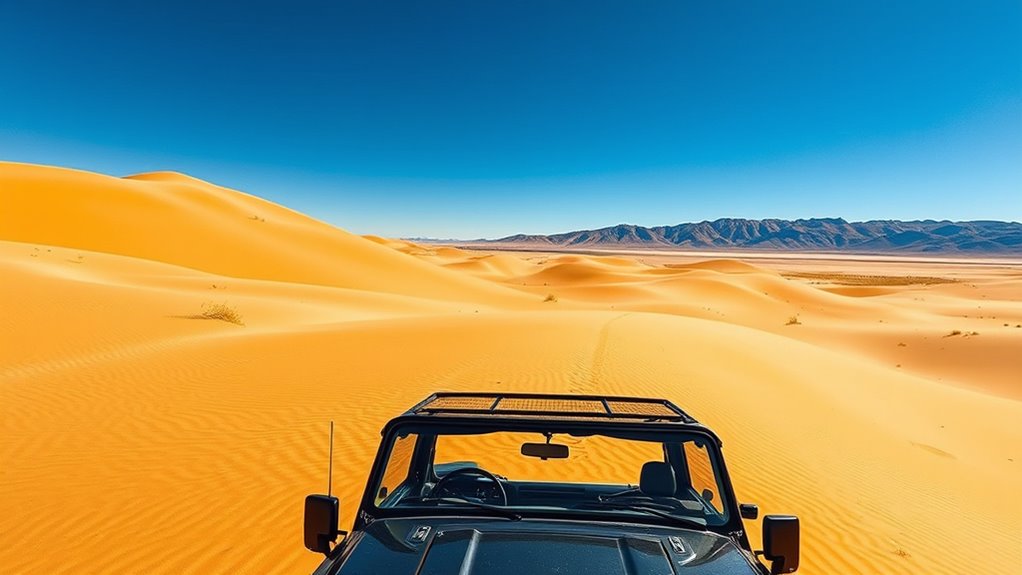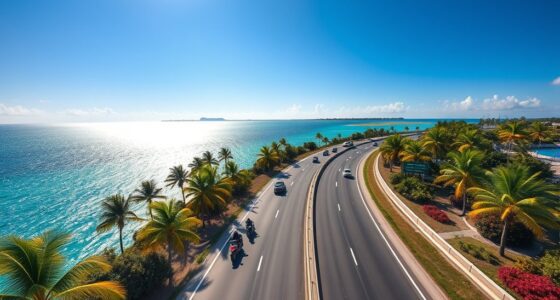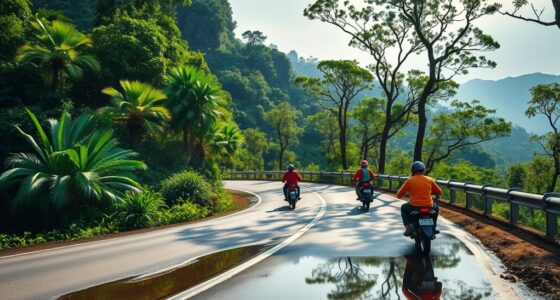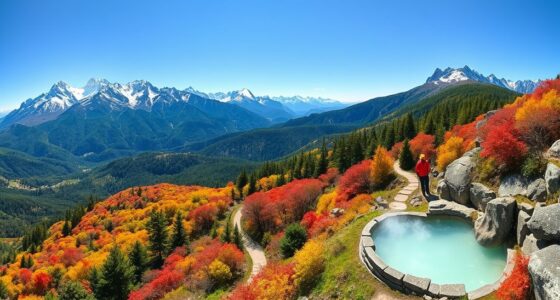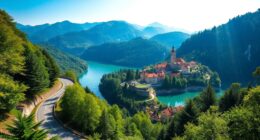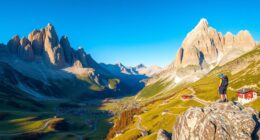Beginning a 4×4 journey through Mongolia’s Gobi Desert offers an incredible adventure filled with stunning landscapes, ancient ruins, and vibrant nomadic cultures. You’ll navigate rugged terrain, visit iconic sights like the Flaming Cliffs, and engage with local communities that showcase their resilience and hospitality. Timing and preparation are essential, and exploring during spring or autumn guarantees the best weather and safety. Keep exploring further to uncover more tips for a successful Gobi loop experience.
Key Takeaways
- Plan routes that include key sights like Flaming Cliffs, nomadic camps, and mountain passes for scenic and cultural experiences.
- Prepare a reliable 4×4 vehicle with spare parts, tools, and essential supplies to handle rugged terrain and potential repairs.
- Travel during late spring or early autumn for optimal weather, avoiding extreme heat in summer and cold in winter.
- Engage with local nomadic communities respectfully, sharing meals and learning about their traditions and resource management.
- Carry navigation tools, extra water, and safety gear to ensure safety and navigation through remote desert and mountain areas.
Planning Your Gobi Desert Loop Adventure
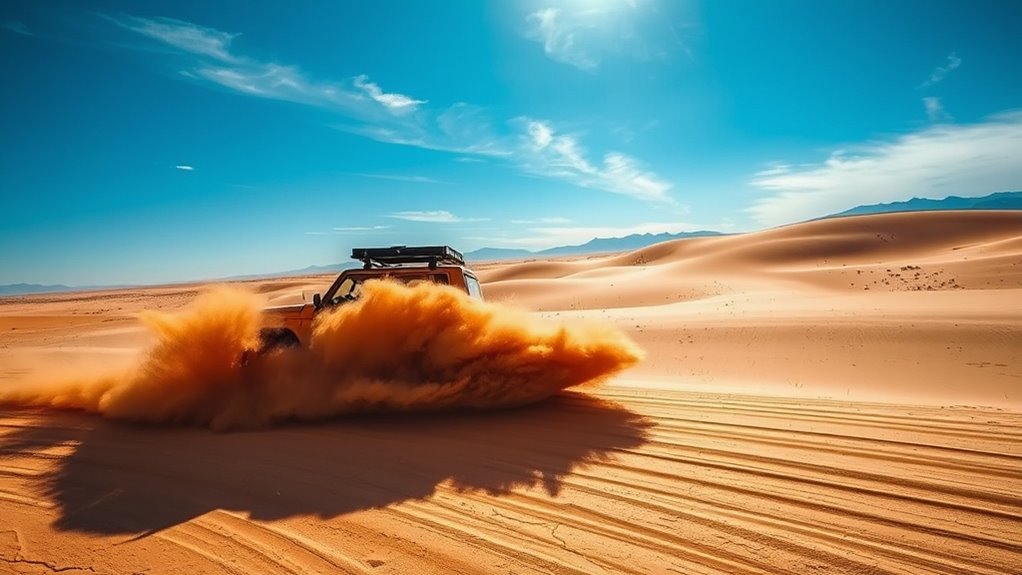
Planning your Gobi Desert Loop adventure begins with thorough research and preparation. You’ll want to understand the desert flora, which varies across different regions, offering unique glimpses of hardy plants adapted to harsh conditions. As you navigate mountain passes, pay attention to their terrain and elevation changes, since these routes can be challenging yet breathtaking. Mapping out your route ahead of time helps you identify key spots for sightseeing and camping, while also ensuring you avoid areas with limited access or difficult terrain. Checking weather patterns is essential, as conditions can change rapidly. By knowing the landscape—desert flora and mountain passes—you set yourself up for a smoother, more enriching journey through Mongolia’s rugged wilderness. Additionally, understanding the surrounding risk factors can inspire better safety preparations and gear choices, ensuring a secure trip in remote environments. Being aware of hazardous conditions common in desert terrains enables you to plan for emergencies and avoid potential dangers effectively.
Essential Gear and Preparations for 4×4 Travel
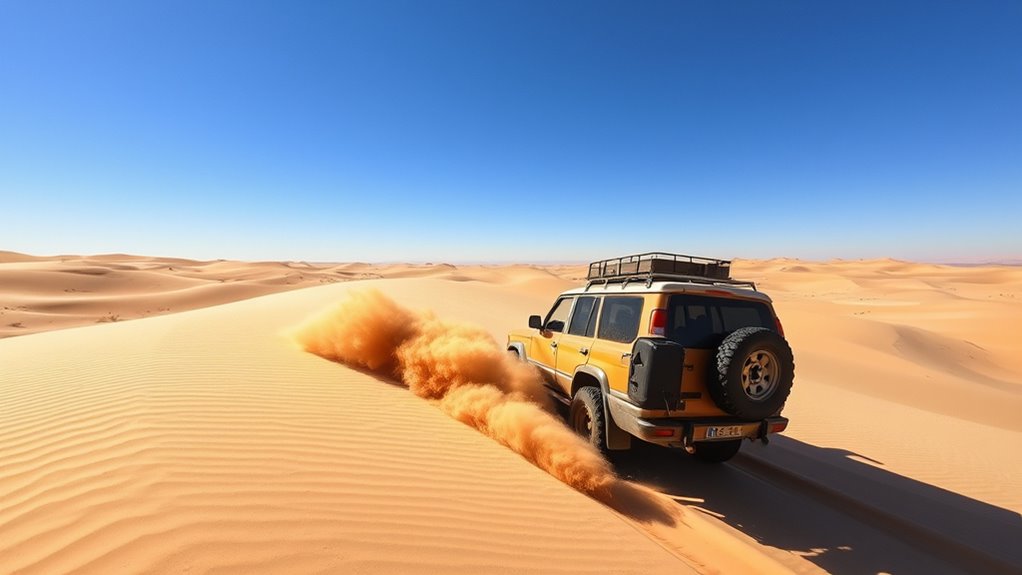
To guarantee a safe and smooth journey through the Gobi Desert, you need to pack the right essential gear and make thorough preparations. Prioritize reliable camping gear, including a sturdy tent, sleeping bag, and portable stove, to assure comfort and safety. Regular vehicle maintenance is vital—carry spare parts, tools, and fluids for quick repairs. Here’s a quick overview:
| Essential Gear | Purpose |
|---|---|
| Camping gear | Shelter, warmth, and cooking facilities |
| Vehicle maintenance tools | Keep your 4×4 running smoothly |
| Extra water and food | Sustain you during long stretches |
| Navigation equipment | Prevent getting lost in remote areas |
Being well-prepared helps you handle emergencies and enjoy your adventure with confidence. Proper planning can significantly enhance your overall experience and safety during the trip. Additionally, considering portable camping gear like tents and stoves can greatly improve your comfort in the desert environment. Ensuring your vehicle readiness involves checking tire pressure and fluid levels to prevent breakdowns. Incorporating vehicle technology such as GPS and adaptive lighting can also aid in navigation and safety during your journey. For optimal home decor organization, integrating functional and stylish wall systems can make your camping setup more efficient and visually appealing.
Navigating Mongolia’s Remote Terrain
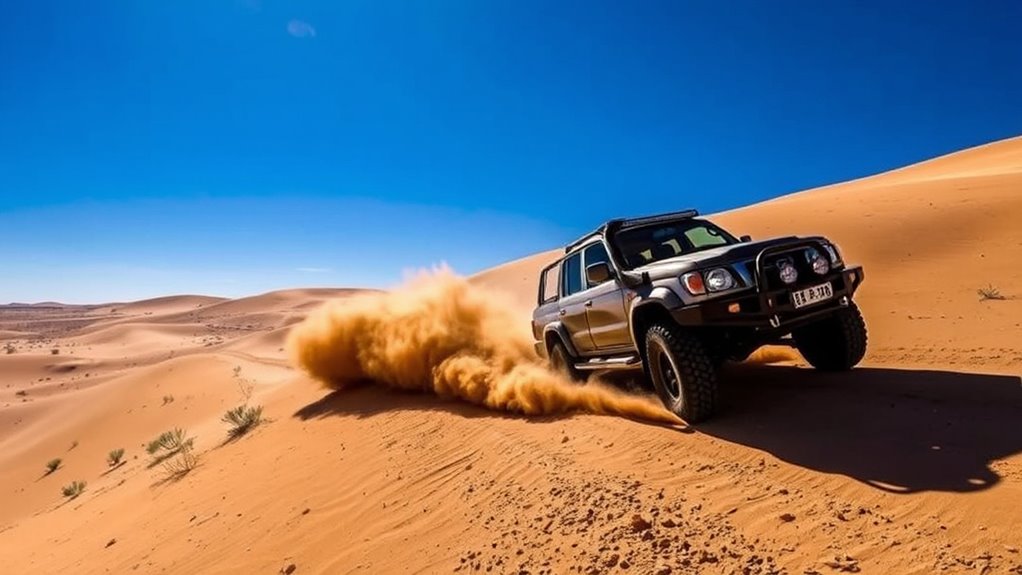
Traveling Mongolia’s remote terrain requires sharp awareness and precise navigation skills, especially after making sure your vehicle is well-maintained and equipped. You’ll need to read the landscape carefully, spotting subtle landmarks to stay on course. Camel trekking can help you explore harder-to-reach areas, but always stay alert for changing terrain. When conditions are challenging, rely on GPS and detailed maps, but don’t forget traditional navigation skills. Desert photography thrives on patience and timing, so plan your stops around the best light and scenery. Keep an eye on your surroundings, as the vast, open desert can be disorienting. Staying vigilant ensures safe travel through Mongolia’s rugged wilderness, allowing you to capture stunning images and enjoy authentic adventures without getting lost. Incorporating traditional and modern navigation techniques into your journey can further enhance your confidence and safety in these remote landscapes. Mastering navigation skills is crucial for exploring unfamiliar terrain confidently and safely. Additionally, understanding terrain features can help you interpret the landscape more effectively and avoid potential hazards. Developing a keen awareness of environmental cues can also aid in recognizing natural landmarks, making your navigation even more precise.
Must-See Destinations Along the Route

As you navigate the Gobi Desert Loop by 4×4, several must-see destinations stand out as highlights of the journey. One such site is the Flaming Cliffs, where vibrant red hues contrast sharply with the surrounding landscape and ancient fossils tell stories of prehistoric life. Nearby, the vast stretches of Gobi desert flora, including hardy grasses and resilient shrubs, paint a picture of survival in harsh conditions. Don’t miss the opportunity to experience true nomadic hospitality at local gers, where you’ll be welcomed warmly and offered traditional dairy products and tea. These stops not only showcase Mongolia’s natural beauty but also offer authentic cultural encounters, making your trip memorable and enriching every step of the way. Promoting good health through authentic local foods can also enhance your travel experience and well-being.
Engaging With Nomadic Communities
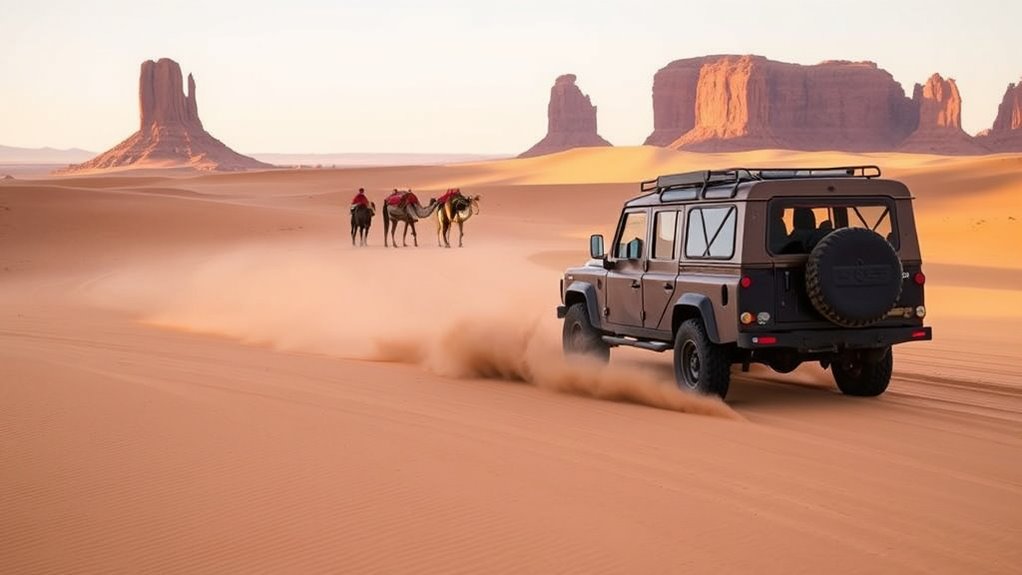
After exploring the iconic sites like the Flaming Cliffs and experiencing the resilient desert flora, engaging with nomadic communities offers a deeper understanding of Mongolia’s living culture. When you visit, take time to observe their greeting customs, which often involve respectful bows and handshakes that reflect warmth and hospitality. Sharing meals provides insight into nomadic cuisine, where you’ll taste hearty dishes like aired cheese and boiled mutton, prepared using traditional methods. Don’t be shy to join in conversations; locals appreciate genuine interest and curiosity. These interactions reveal a lifestyle rooted in resilience and community, helping you appreciate how nomads adapt to the harsh desert environment. Connecting with them enriches your journey, transforming it into a meaningful cultural exchange. Respectful greetings demonstrate the significance of social bonds in nomadic life. Engaging with their traditions and customs can further enhance your understanding of their resilient way of living. Recognizing the importance of cultural practices deepens your appreciation for their adaptive strategies in the desert landscape. Additionally, understanding local resource management reveals how they sustainably utilize the scarce desert environment to support their lifestyle. Building trust and rapport with nomadic families often involves learning about their emotional support systems and community-based resilience strategies, which are vital for thriving in such a challenging environment.
Discovering Ancient Ruins and Cultural Sites
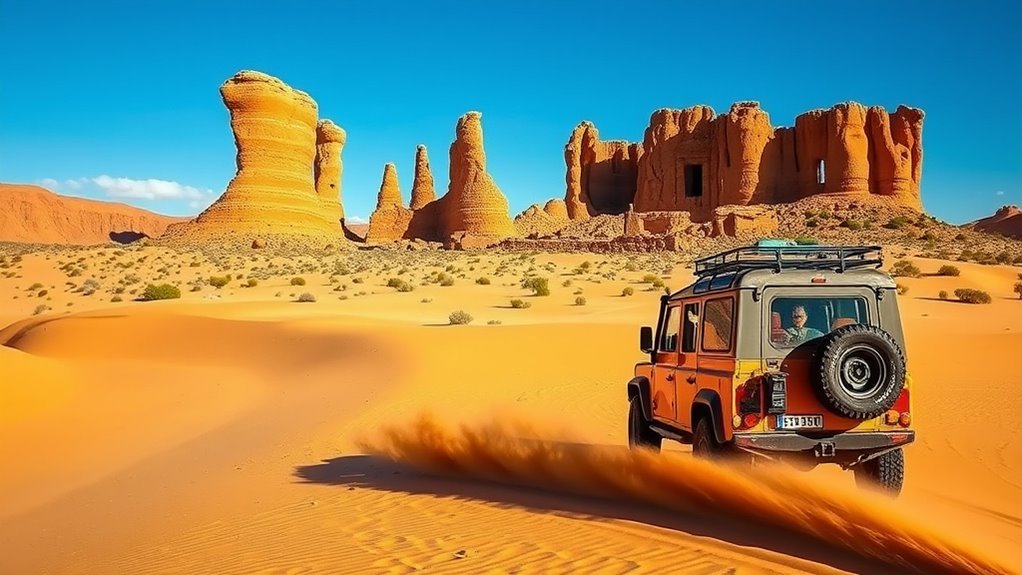
Venturing into the Gobi Desert reveals a wealth of ancient ruins and cultural sites that tell the story of Mongolia’s rich history. As you explore, you’ll encounter remnants of ancient trade routes that once connected Asia to Europe, offering insight into historic commerce and cultural exchange. Alongside these routes, desert flora like hardy grasses and resilient shrubs cling to life, highlighting the desert’s unique ecosystem. You might stumble upon archaeological sites such as petroglyphs, stone cairns, and old caravan stops, each revealing stories of nomadic tribes and travelers who traversed these lands centuries ago. These sites provide a tangible link to Mongolia’s past, allowing you to immerse yourself in the cultural tapestry woven through centuries of resilience and interaction in the heart of the Gobi. Studies show that Glycolic Acid benefits are often used to preserve and rejuvenate skin, which might be relevant when considering the care of archaeological artifacts or even cultural artifacts in the region. Additionally, understanding the ancient trade routes can enhance appreciation for the historical significance of these sites, as they played a crucial role in shaping regional history and cultural development. Recognizing the importance of cultural preservation in archaeological work helps safeguard these priceless remnants for future generations. Exploring these routes also provides insight into the trade networks that facilitated cultural exchanges and economic growth across Asia and Europe. Furthermore, research into archaeological techniques has improved the accuracy and preservation of findings, ensuring that these historical treasures remain intact for study and appreciation.
Wildlife and Natural Wonders of the Gobi
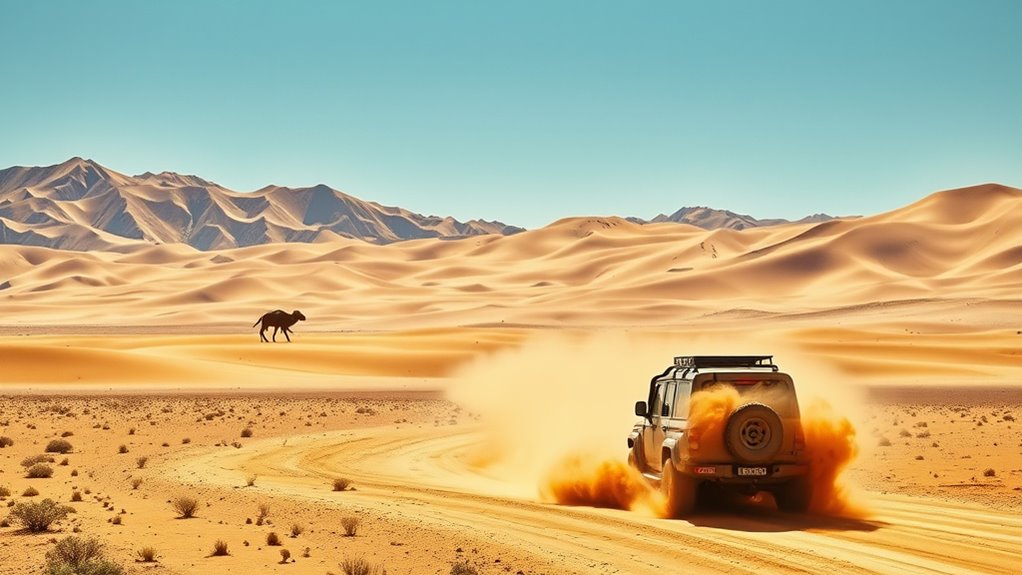
The Gobi Desert’s ancient ruins and cultural sites are just one aspect of its fascinating story; its natural environment teems with unique wildlife and breathtaking landscapes. You’ll encounter resilient desert flora that survives harsh conditions, like hardy grasses and low shrubs. Spot rare species such as the Bactrian camel, Gobi bear, and elusive snow leopards if you’re lucky. As the sun sets, the Gobi transforms into a stargazer’s paradise—clear night skies reveal countless stars, planets, and constellations. Nighttime stargazing here offers a mesmerizing experience, far from city lights. The desert’s natural wonder lies not only in its striking vistas but also in its ability to support diverse life forms amid rugged, arid terrain. It’s a truly unique environment that captivates explorers at every turn.
Tips for Safe and Responsible Exploration
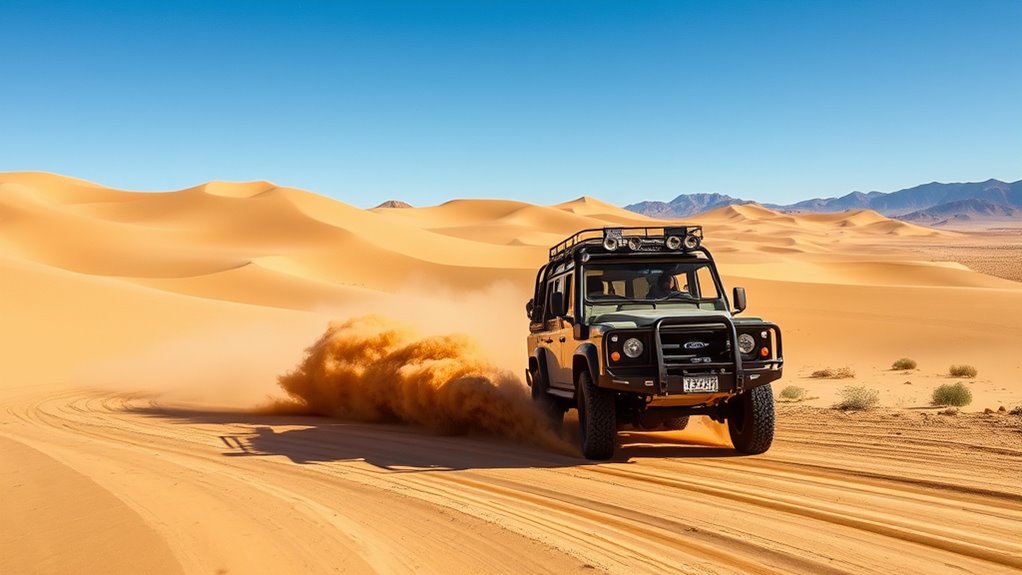
Exploring the Gobi Desert requires preparation and awareness to guarantee both your safety and the preservation of its fragile environment. Practice ethical travel by respecting local customs and minimizing your impact. Always stay on designated paths to prevent environmental degradation and protect natural habitats. Carry enough water, fuel, and supplies, and inform someone about your route. Use the following table to understand key safety tips:
| Tip | Explanation |
|---|---|
| Respect local communities | Support local businesses and be courteous. |
| Leave no trace | Pack out all waste and avoid damaging flora and fauna. |
| Stay on marked trails | Prevent erosion and protect ecosystems. |
| Avoid disturbing wildlife | Observe from a distance without causing stress. |
| Prepare for emergencies | Carry first aid and communication devices. |
Best Time to Embark on the Gobi Loop
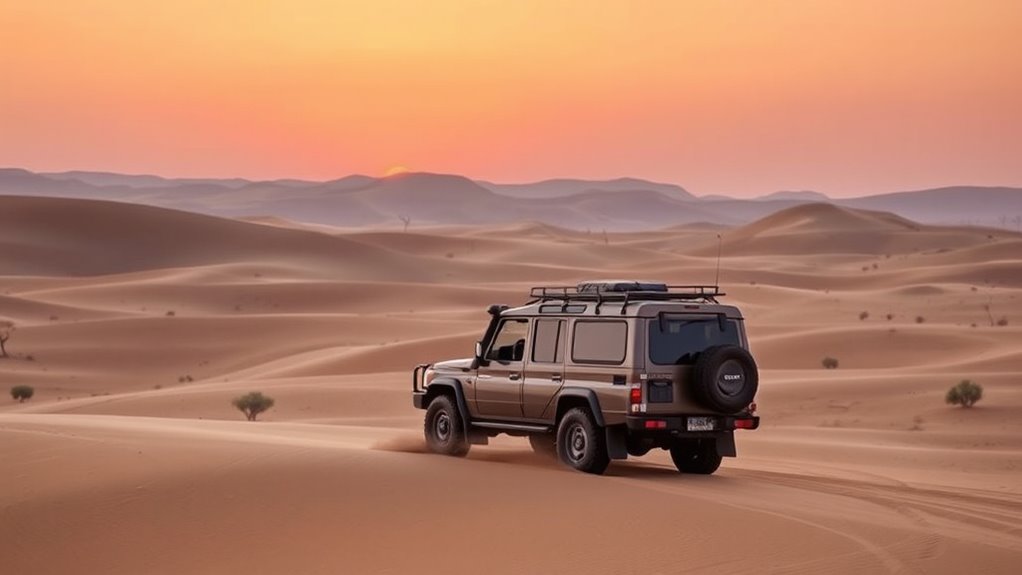
Timing your trip to the Gobi Desert is crucial to guarantee ideal weather conditions and a safer adventure. The best time to commence on the Gobi Loop is during late spring (May to early June) or early autumn (September to October), when climate considerations favor milder temperatures and less extreme weather. Summers can be scorching, and winters are harsh, making travel difficult and potentially dangerous. Additionally, aligning your trip with seasonal festivals adds cultural richness and local vibrancy. Visiting during these periods allows you to experience traditional celebrations and makes for more comfortable exploration. Avoid the extreme heat of midsummer and the cold of winter for a safer, more enjoyable journey through Mongolia’s stunning desert landscapes.
Frequently Asked Questions
What Are the Visa Requirements for Traveling Through Mongolia’S Gobi Desert?
You need to understand visa regulations before traveling through Mongolia’s border crossings. Most travelers require a visa, which you can obtain in advance or upon arrival at certain border points. Make sure your passport is valid for at least six months. Check specific border crossing requirements, as some may demand additional documents or visas. Planning ahead guarantees smooth entry and a hassle-free adventure exploring Mongolia’s Gobi Desert.
How Do I Handle Vehicle Breakdowns in Remote Gobi Areas?
When a vehicle breaks down in remote Gobi areas, you should stay calm and prioritize safety. Use your emergency preparedness kit for immediate needs, and attempt basic vehicle repair if possible. Keep communication devices handy, like a satellite phone, to call for assistance. It’s essential to have a plan for emergency situations, including knowing local contacts or guides, so you can get help quickly and avoid danger in these isolated regions.
Are There Guided Tours Available for the Gobi Desert Loop?
Imagine exploring the Gobi Desert with ease—you’ll find guided tour options that make your adventure seamless. Many operators offer these tours, often including custom itinerary planning tailored to your interests. With a guided tour, you gain expert insights, safety, and convenience, allowing you to focus on the breathtaking landscapes. Whether you’re seeking a structured journey or personalized experience, these tours guarantee you enjoy the Gobi’s wonders without worry.
What Communication Options Are Reliable in the Gobi’S Wilderness?
In remote areas like the Gobi Desert, you’ll want reliable communication options. Satellite phones are your best bet, offering connection even without cell service. Emergency beacons are also essential; they can alert rescue teams if you get into trouble. Always carry both devices, keep them charged, and test them beforehand. This way, you stay connected and safe while exploring the wilderness, no matter how isolated you get.
How Can Travelers Support Local Nomadic Communities Sustainably?
You can support local nomadic communities sustainably by respecting their cultural preservation and nomadic livelihoods. Opt for eco-friendly tours that benefit locals directly, such as staying in community-run guesthouses or participating in traditional activities. Avoid over-tourism and purchase handmade crafts, which help sustain their economy. By being mindful and respectful, you contribute to preserving their unique culture and ensuring their livelihoods thrive for generations to come.
Conclusion
Beginning on Mongolia’s Gobi Desert loop is like chasing a mirage—full of surprises that shimmer just beyond reach. With your spirit of adventure as your compass, you’ll weave through rugged landscapes and ancient stories etched in stone and sand. Embrace the wild, connect with nomads, and let the desert’s silent song guide you. This journey isn’t just a trip; it’s a fleeting moment of eternity, waiting to be captured in your memories.
